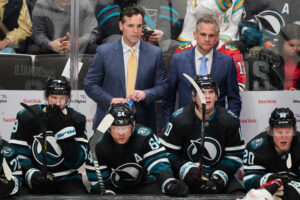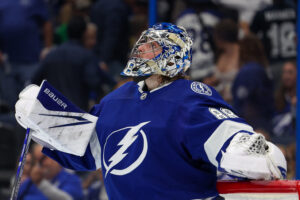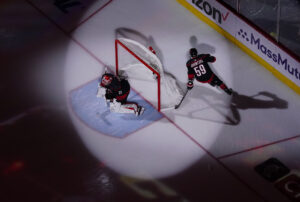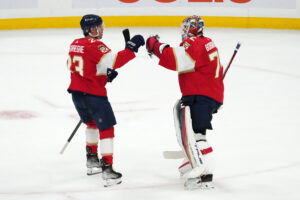The 2019-20 San Jose Sharks began the season with just two NHL-proven right-shot right wingers: a hopefully ascending Kevin Labanc and a definitely descending Melker Karlsson. Not only were the Sharks short two NHL-proven right wingers, the two they had were lower line talents. The Sharks had a roster hole. They hoped their AHL talent could step up and solve the problem. That didn’t happen. And while Karlsson continued his regression, Labanc surprisingly joined the regression party. This roster hole played a meaningful role in the Sharks difficult season.
Previously: Season Overview
Up now: The Forwards
Up next: The Defencemen
The Sharks began the season with depth down the middle, with Logan Couture, Joe Thornton, Tomas Hertl and Barclay Goodrow. This was not among the league’s premier centremen groups, but it was capable of holding their own against most teams. The Sharks counted on their powerful left wingers, notably Timo Meier and Evander Kane, to carry a big load. Behind those two, the Sharks were, once again somewhat limited.
2019-20 San Jose Sharks Opening Night Forwards
The opening night lineup clarified the issue. It featured four aspiring forwards, none locked into the NHL. Danil Yurtaykin, Lukas Radil, Dylan Gambrell and Lean Bergmann combined that night for 54 minutes of ice time. Gambrell would go on to play 50 generally uninspiring games for the 2019-20 San Jose Sharks, Radil’s 14 games was next best. Night after night, the forward group was dragged down by players who were NHL tweeners (players good in the AHL but not NHL ready). The limited talent was problematic, but the absence of chemistry played a role. One doesn’t need great talent if they work well with others. The Sharks youth had limited talent and limited chemistry with the better players.
To stem the deficiencies, the Sharks added two veteran forwards; Patrick Marleau was signed in mid-October for game 5 (the team was winless through four games) while Stefan Noesen was claimed off waivers in December. They both helped and the Sharks lower lines benefited. But this was not enough to turn things. One imagines both will be with the Sharks next season. Though Marleau was traded in the latter part of the season, his re-return is likely.
2019-20 San Jose Sharks Key Forwards
Truth be told, this was a season where almost every veteran forward on the team regressed. Meier led the team with 49 points, but was minus-18 during 5-on-5 play. Meier’s physical play was met with an abundance of physical play from opposing defencemen and it seemed to take a toll. Kane excelled on special teams, leading the team with 14 power play goals and winding up a superb plus-1 on the penalty kill. Alas, he was highly penalized again this season and wasn’t nearly as effective as needed during even strength play.
Logan Couture was the team’s best forward, though injuries cost him 18 games. Tomas Hertl was the biggest disappointment. As with Meier, opponents handled his physical play better this season than in seasons’ past. Hertl’s game regressed substantially. He’d finish the season with torn knee ligaments (not the same knee which required surgery his rookie season). Given the recovery times involved, it is unlikely he’ll be fully healthy until past the midpoint of next season.
Goodrow was the team’s Swiss Army Knife and the lone forward to improve this season, but was traded in February. Marleau’s return to San Jose was modestly successful, though his power play contributions, a historic strength, were almost non-existent. Joe Thornton was healthy during the offseason for the first time in three years. But his decline continued, somewhat of a disappointment given his healthier status. Thornton expressed disappointment at not being traded at the trade deadline to a contender. Perhaps this is an indicator his declining play was noticed by other teams as well.
2019-20 San Jose Sharks Forwards Bright Spots?
If there was anything positive for the Sharks to carry into next season, it is the duo of Joel Kellman and Noah Gregor. Overall, Gregor wasn’t great, with a meager three even strength points in 28 games. On the positive side, he demonstrated an improved feel for the NHL game as his playing time increased. He showed enough skill and talent to suggest he’ll take another step. Plus he added speed to a line-up which needs it. Kellman was the biggest surprise. The Swedish import plays a savvy game and may well wind up a fixture on the Sharks fourth line. Still, when the two “bright spots” scored five points in one case and seven in the other, it is tough to get overly excited.
Regressions and Opportunities
The optimism surrounding Labanc faded. I wasn’t sold on him, though many thought he’d take a big step this season. He did, just in the wrong direction, dropping from 56 points last season to 33 this (in 12 fewer games). The team also struggled with Labanc on the ice. His goals for (GF%) was 50% last season, 38.5% this season.
Two lower line Swedes failed to impress, including the veteran Karlsson. He had his worst season in teal and is unlikely to return for next season. He doesn’t seem able to maintain the level of physicality to play at the NHL level any longer. I was among those who expected him to get moved at the trade deadline. I’d guess there was a lack of interest, since the Sharks would have taken just about anything. Fellow Swede Marcus Sorensen, once so promising, also struggled this season. Sorensen has a lot of positive characteristics, but his scoring touch just disappeared. He had more than his share of good chances, but was rarely able to find the back of the net. As a result, his goal total plummeted from 17 last season to just seven this season (14 fewer games).
It isn’t clear if Antti Suomela did enough for the Sharks to continue on with him, he played in just 20 games and averaged a shade under 10 minutes a game. Alexander True looks like he could use more AHL time, but the big-bodied Dane is close and could find his way to the NHL next season.
Passing Forwards
When people looked at the Sharks vulnerabilities, one stood out, the hole at right wing. And yes, it was an issue. But a more subtle issue proved greater.
In our preview, we noted the loss of the Sharks passing forwards – the set-up players who create the scoring opportunities for others. Not long ago, the Sharks have four superb passers in Joonas Donskoi, Chris Tierney, Joe Pavelski and Joe Thornton. Only Thornton remains, a diminished version of the elite passer he was even just a few seasons back. How bad was it for the 2019-20 San Jose Sharks? The team leader in even strength assists was Meier, with a meager 20. It was the lowest team-leading assist total (among forwards) in the league.
Far too many offensive possessions ended with a missed pass by Sharks forwards. And to make matters worse, far too often, they led to quick strike opportunities for opposing teams. But even when the Sharks didn’t turn the puck over or lose possession on a so-so pass, they lost opportunity. There were simply too many times where a good pass would accelerate play, but instead, a Sharks forward made a pass slightly off target, and play slowed it down.
The Sharks need forwards who can create time and space passing the puck. Forwards who can accelerate play and drive scoring opportunities through effective passing. The absence of these forwards showed just how much the 2019-20 San Jose Sharks missed this skill.
Power Forwards
The Sharks are a power forward team, but the keys to this, Kane, Hertl and Meier, all had difficult seasons. The lone forward to consistently drag the puck behind the net was the aging Thornton.
The Sharks have tremendous right-shot defencemen in Brent Burns, Erik Karlsson and Tim Heed. There’s a clear formula for pairing power forwards with big shot defencemen. Use the power forwards behind the net, forcing defenders down low. This opens up the maximum space for the puck to get cycled up high to the dangerous blueliners. This combination stretches a defense and creates open space in the slot areas for shots, re-directs or cross-ice passes. These are all effective scoring weapons. Alas, the Sharks forwards seemed too content on the outside and not behind the net, stalling the offense repeatedly.
The Sharks identity relied on power forwards playing like power forwards. Like so many other things, it didn’t happen for 2019-20 San Jose Sharks.
2019-20 San Jose Sharks Forwards Underwhelm
Coning into the season, the risks were apparent. Perhaps the Sharks history of getting to the playoffs created an undue amount of optimism, but this team was vulnerable from the start and the forward group was a key part of this vulnerability.
A few seasons back in 2015-16, the Sharks pinned their hopes on the growth of a number of younger forwards and it paid off. Donskoi, Tierney and Matt Nieto all contributed and the Sharks went to the Stanley Cup Final.
This season, the Sharks took a similar approach, but with very different results. This season’s young forwards weren’t comparable to the 2015-16 class.
Still, even skeptics didn’t anticipate the broad regression among the forward group, especially among the veterans. Yes, there were too many starters who weren’t NHL ready, but there were remedies to this. Yet, even adding NHL capable players like Marleau and Noesen proved inadequate. It wasn’t just the youth.
In the end, the Sharks forwards didn’t play well collectively. They had skill gaps, most notably when it came to passing the puck. The youth was, for the most part, not ready. And the team misused their power forwards, failing to have them play consistently from behind the net.
As a result, the 2019-20 San Jose Sharks forward group underwhelmed. Even the bright spots didn’t shine that brightly. The Sharks forwards had numerous problems this season, but perhaps the most troubling signs are these two: players in the twilight played like players in their twilight. But the players expected to ascend, didn’t.







